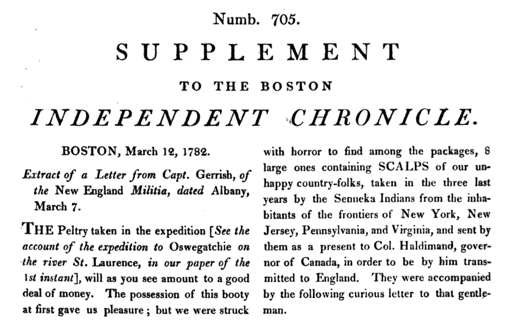In 1782….
… the new United States was negotiating for a treaty with Great Britain. But things were moving a bit to slowly for Benjamin Franklin, who took up the fake news strategy writing an entirely made-up, fake letter.
The letter, (purportedly from Capt. Samuel Gerrish) was printed in such a way as to look like a regular newspaper supplement. Even though he was in France at the time, being a printer, Franklin could get easy access to a print shop, so making it look “real” was simple for him. Few other people at the time could do this.
By April 22, Franklin had made up this fake news story, purportedly published as a supplement to a Boston newspaper. Not since he and Lafayette had drawn up a “List of British Cruelties” in 1779 had he written in such detail about the cruelties that were committed by the British and their allies. He wrote John Adams, “it might make them a little asham’d of themselves.” He was explicitly looking to influence public opinion as the peace negotiations got under way. Sound familiar?
In Franklin’s fake letter, “Captain Gerrish” describes the horrors of Indian atrocities (he reports seeing giant bundles of scalps taken from innocent settlers, men, women, children) in an effort to get Britain to react in sympathy and encourage the peace negotiations that were then underway.
(It’s useful to remember that the Indians were largely British allies. Franklin was hoping to make the Brits feel guilty about the atrocities committed in their name, thereby helping the peace negotiations go more rapidly.)
I haven’t yet found a digital copy of the original supplement, but the text is reprinted in Memoirs and Life of B. Franklin (1818).
The fake news story was apparently believed by a few people including a reprint of the letter (but without any understanding it was written by Franklin) in the 1808 book “Medical Repository, Vol. 5“
A nice analysis of the hoax (and whether or not the hoax succeeded) can be found in the National Archives essay about the affair: “Founders Online: Supplement to the Boston Independent Chronicle (before 22 April, 1782)”
Fake news has always been with us. It’s just disseminating far more rapidly these days–you don’t need to set up hot type and run each page by hand.
In other SRS news…
Remember the “masses of ladybugs” SearchResearch Challenge from a couple of weeks ago?
This week I’m writing the SearchResearch blogpost from my scholarly residence at Schloss Dagstuhl. Here, in the Saarland of southwestern Germany, it’s early spring. The snow drops are beginning to flower, despite the occasional flurries of light snow with the occasional bit of thunder and lightning.
I had my window open, and as I was writing, this ladybug flew in and started to read what I was working on at the moment…
I don’t know, perhaps the ladybugs knees were bothering it in the spring storm.
Later this week there will be another SearchResearch Challenge. Until then…
Search on!







